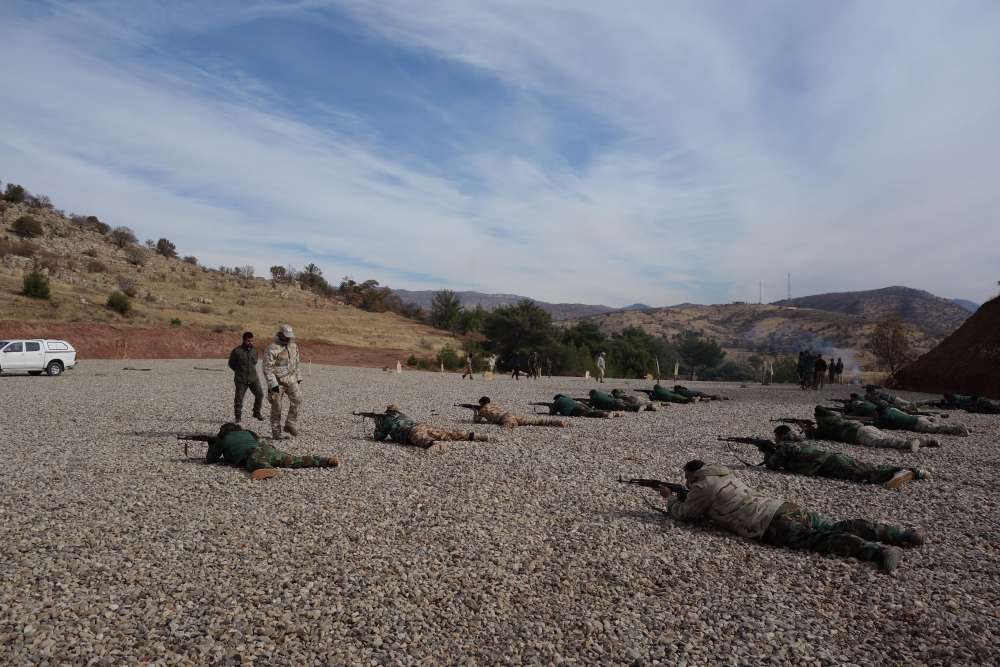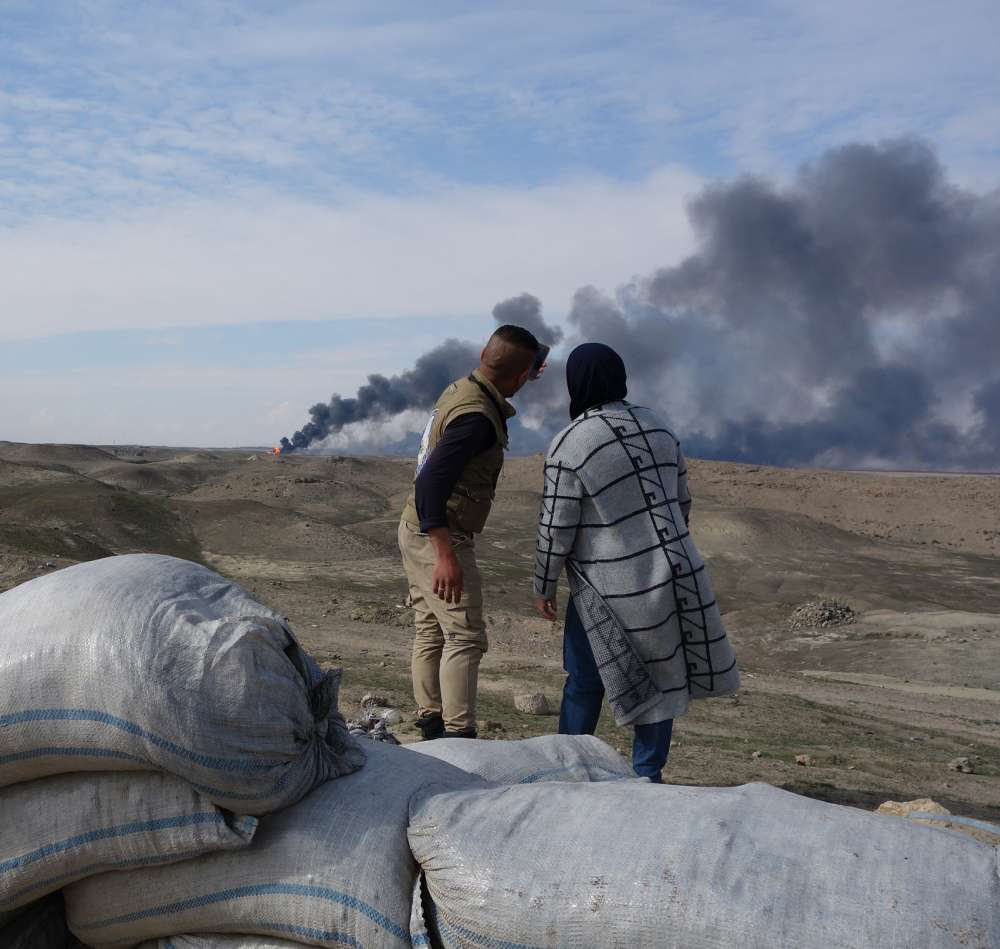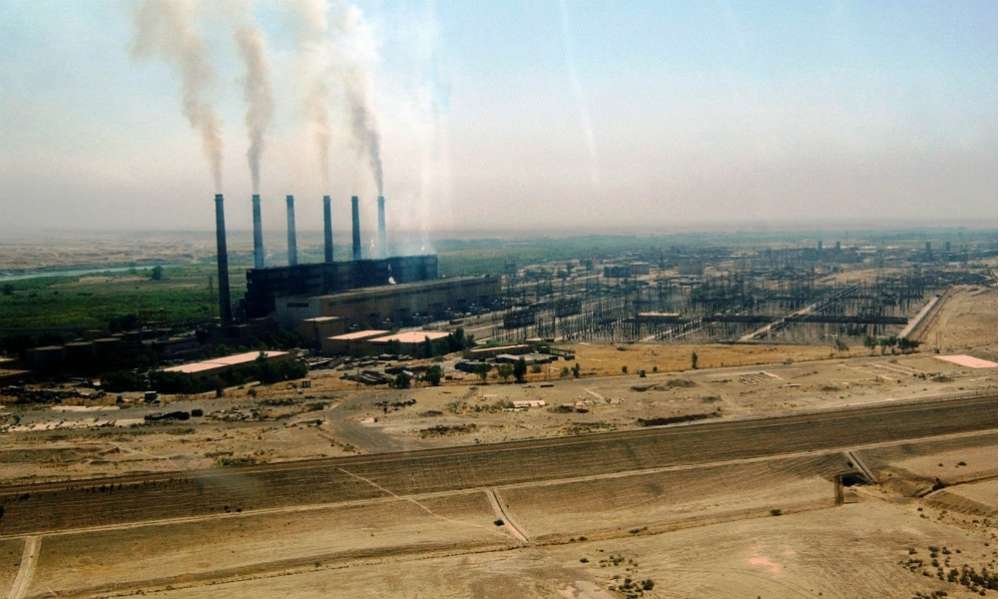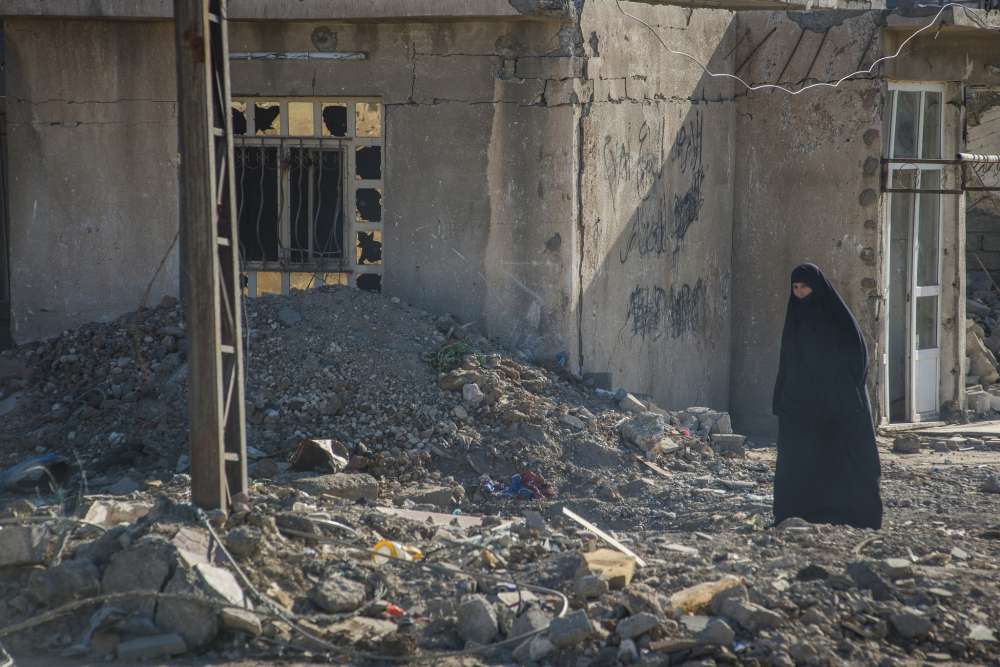Who’s Who: Quick Facts About Local and Sub-State Forces

This backgrounder is part of a larger study on the role and impact of Local, Hybrid or Sub-state Security Forces (LHSFs) in Iraq. The research surveyed the role played by different local or sub-state groups across three governorates, Ninewa, Salah ad-Din, and Kirkuk, and the impact for local communities and national political dynamics. A range of LHSFs appeared in the 11 areas where field research was conducted. This reference guide provides a summary of the key attributes and important background information about the most significant LHSFs, as well as some of the smaller LHSFs that appeared in particular areas of the field research. Each of these LHSFs has slightly different relationships with the two main governance actors – the Baghdad-controlled Iraq government and the Kurdistan Regional Government (KRG) – and with local communities in areas where they are active. To help reflect these divisions, this reference guide has been organized into three subsections:
- Popular Mobilization Forces (PMF) – This umbrella group reporting to the Iraqi government in Baghdad was created in mid-2014 to organize the popular mobilization of pre-existing and new militia groups and forces into the fight against ISIL. Although the most prominent groups are Shi’a forces from southern Iraq, the PMF includes sizeable Sunni forces, and a range of minority forces drawn from different areas.
- Kurdish Security Forces (KSF) – The majority of forces belonging to the Kurdistan Regional Government (KRG) are controlled by either the Kurdish Democratic Party, the Patriotic Union of Kurdistan, or belong to one of the mixed brigades under the Ministry of Peshmerga Affairs. However, there are also a range of local forces, many drawn from minority communities in liberated areas that act as subsidiary or affiliated forces to different KSF.
- Kurdistan Workers’ Party (PKK)-affiliated groups – Although forces affiliated with the PKK did not feature strongly in the field research, they are an important part of the LHSF landscape in Iraq and are distinct from either PMF or KSF. PKK forces also have a number of local affiliates in liberated areas, many drawn from minority communities in the areas examined in the research.
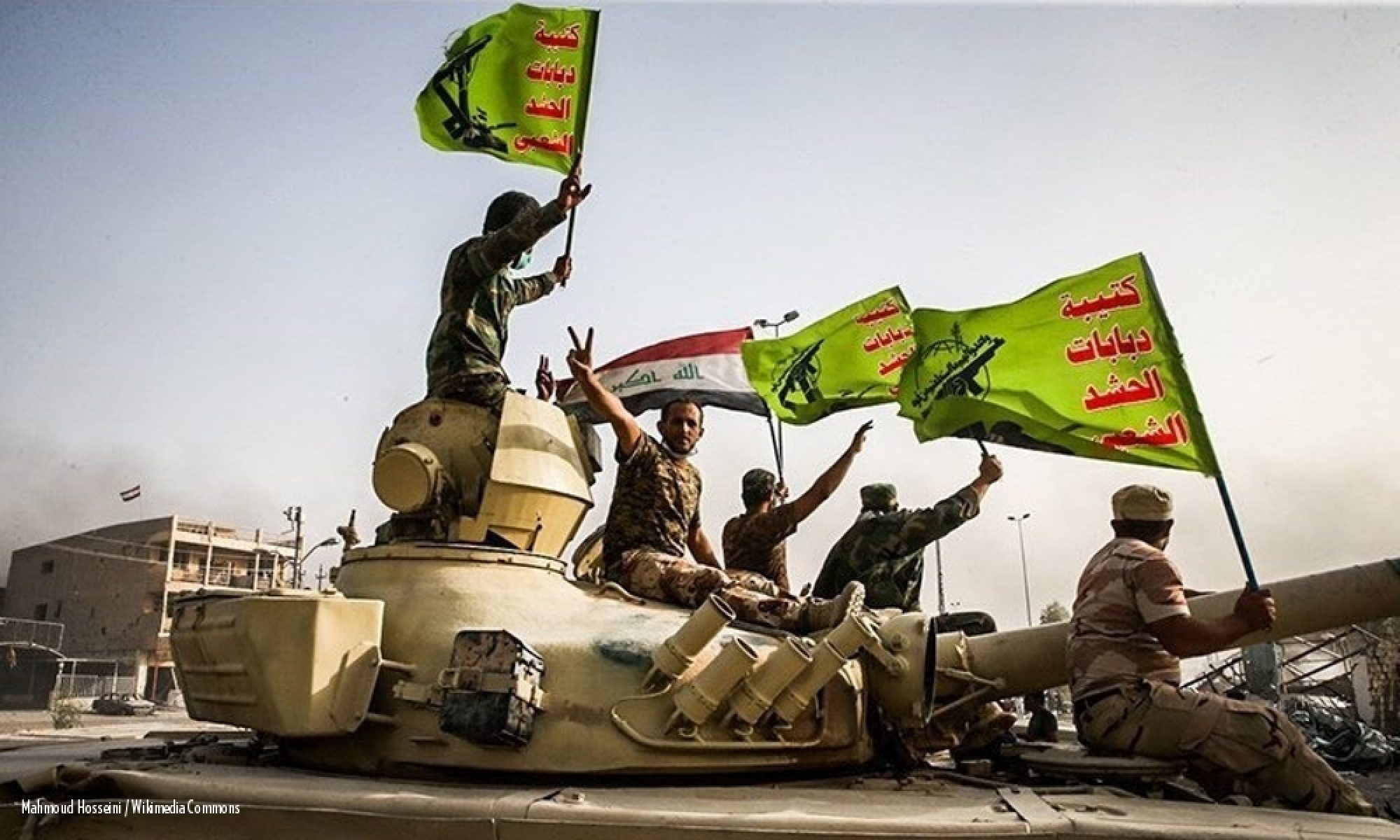
Popular Mobilization Forces (PMF)
Following the fall of Mosul and ISIL’s rapid expansion across northern Iraq, in June 2014, Iraq’s most important cleric, Grand Ayatollah Ali al-Sistani issued a fatwa that acted as a call to arms and prompted a mass mobilization effort, collectively described as the Popular Mobilization Force (PMF), also known by the Arabic term al-Hashd al-Shaabi. The PMF were organized under the Prime Minister’s office, and granted some quasi-governmental status and government salaries. As of February 2016, 120,000 PMF salaries were on budget, although it is difficult to know how closely that number approximates actual fighting forces, potentially as few as 60,000.1 Then in November 2016, Parliament passed a law legalizing PMF, granting them equivalent ranks, benefits, and subject to the same military jurisdiction as ISF.
The PMF comprises a minimum of 50 subgroups, although new groups emerge periodically in the ongoing conflict. Some of these groups have been longstanding since the 1980s, while others formed more recently in response to the threat from ISIL following the fatwa by Al-Sistani.2 The Popular Mobilization Commission, led by National Security Advisor Falih al-Fayyadh,3 reports to the prime minister’s office. However, the largest and most long-standing Shi’a PMF groups are more responsive to their own militia leaders, and some more directly responsive to Iran than to Iraqi leaders.
Most PMF forces draw predominantly from Shi’a populations in southern Iraq, but since 2014 sizeable Sunni forces have also been incorporated into the PMF umbrella, particularly once the PMF was legalized in 2016 as the only legitimate route for having a non-state or substate armed force. The most significant mobilization effort was a partially US-sponsored initiative known as the Tribal Mobilization Force (TMF) in Anbar and Ninewa that sought to recruit tribal forces to play a role as local “hold” forces in their areas once liberated from ISIL. Shi’a Turkmen, Shabak, Christian and Yezidi forces have also been gradually mobilized from across the liberated areas, and now form units within the PMF. Many are directly recruited or affiliated with larger Shi’a PMF operating in their local areas.
This charts below summarize some of these different PMF forces, focusing in particular on those that were prominent in the field research. This section will be organized based on different affiliations or dynamics among these different PMF forces: 1) the larger Shi’a PMF that receive substantial support and are affiliated with Iran; 2) other Shi’a PMF who have a different position and relationship with both the Iran and Iraq governments; 3) Sunni PMF; 4) Other minority forces within the PMF.
Iran-affiliated Shi’a PMF
Many of the largest and most influential forces within the PMF are heavily influenced (and some controlled directly) by Iran. These include the Badr Organization, the League of the Righteous (Asa’ib Ahl al-Haqq), Hezbollah Brigades (Kata’ib Hizb-Allah), and the Khorasani Brigades. These militias are the best organized, best equipped and paid (with reports that Iran supports their salaries as well as equipment), and play a leadership role among other groups within the PMF. The leader of Badr Organization Hadi al-Amiri and the leader of the Hezbollah Brigades Abu Mahdi al-Muhandis significantly direct inter-PMF cooperation. Although there is imperfect command and control in the PMF and no direct linear responsibility, they are de facto responsible for much of the tactical and political decision-making of the PMF, and may direct operations for multiple PMF groups, including outside of their own groups.
Badr Organization (Munazzama Badr; al-Jinah al-Askari)4
Formed: 1983
Active: Yes
Strength: Around 20,000 as of February 20165
Leader: Hadi al-Amiri
Link to political party: Badr Organization
- Longest-standing and largest PMF, formed by Iraqi exiles in Iran during the 1980s (as the “Badr Brigades”)6
- Developed active political arm after the 2003 US invasion, and integrated into Iraqi government structures, despite still significant ties to Iran
- Have 22 seats in Iraq’s parliament;7 Badr member Mohammed Ghabban held the key post of minister of interior (federal police, intelligence) until resigning in June 2016.7 Since January 2017, Qasim Mohammad Jalal al-Araji, a senior Badr member, has been minister of interior.9
- Hadi al-Amiri, the leader of Badr, served as Transportation Minister from 2011 – 2014.10 Famous military success in early victory over ISIL in Jurf al-Sakhar (Babel governorate), and Amerli (Tuz district) in 2014
- Reputation generally better in terms of conduct than Asa’ib Ahl al-Haq, Hezbollah Brigades, or the Khorasani Brigades; however, there have been serious allegations or rights abuses in some operations, particularly regarding unlawful detentions and poor treatment and abuse of detainees11
- Has a large Turkmen force in southern Kirkuk and southern Tuz (see below)
League of the Righteous (Asa’ib Ahl al-Haqq)
Formed: 2006
Active: Yes
Strength: 5,000−10,000 as of March 2015
Leader: Qais al-Khazali
Link to political party: Al-Sadiqun
- Splinter group from the Mehdi Army (officially disbanded in 2008), with alleged close ties to former PM Nouri al-Maliki and seen as the special operations unit of the PMF12
- Allegedly has received as much as $1.5-$2M a month from Iran13
- Several current or former commanders designated by US as global terrorists for attacks on US forces from 2006 – 200914
- Refused to participate in Tikrit operation in opposition to US involvement (but after US insisted that it be withdrawn because of terrorist links)
- Alleged HR violations in several operations (summary executions, kidnapping, arbitrary detention, torture, looting, mass destruction of houses); for example, in Tuz district, Muqdadiya (in Diyala), and Tikrit15
- Had a tiny locally based Sunni Arab contingent in al-Alam, Tikrit,16 where HRW later alleged destruction by Sunni forces
- Reportedly receives additional income from criminal activities17
Hezbollah Brigades (Kata’ib Hezbollah)18
Formed: 2007
Active: Yes
Strength: Around 20,000 as of February 201619
Leader: Jamal Jaafar Mohammed (aka Abu Mahdi al-Muhandis)
- Strongly supported via Iranian Revolutionary Guards and Lebanese Hezbollah for training and advice
- Only PMF listed as a terrorist group by the US (since 2009), with the leader designated as global terrorist (since 2009)20
- Formed the Harakat al-Nujaba (HN) in Syria in 2013. Leader of HN publicly stated he would support Iran’s efforts to overthrow the Iraqi government21
- Leader of Hezbollah Brigades, Abu Mahdi al-Muhandis, is also the vice president of the PMF committee and its head of operations22
- Alleged HR violations in several operations (summary executions, kidnapping, arbitrary detention, torture, looting, mass destruction of houses) – for example, in Tuz district, Muqdadiya (in Diyala), and Tikrit.23 Abuses are also alleged to be highly sectarian, particularly against Sunnis24
Imam Ali Brigades (Kata’ib al-Imam Ali)25
Formed: 2014
Active: Yes
Strength: n/a
Leader: Shibl al-Zaydi
Link to political party: Harakat al-Iraq al-Islamiyah
- New, well-trained and equipped Iranian proxy militia with close links to Hezbollah Brigades and Iran’s Quds Force
- Abu Azrael, a commander, is a famous fighter that made waves in the media;26 he was also praised by Sistani’s office
- Alleged HR violations, including beheading and burning of prisoners27
- Trained two Christian units called Kata’ib Rouh Allah Issa Ibn Miriam Brigades and Babylon, as well as a Yazidi group, the Sinjar brigade28
Khorasani Brigades (Saraya al-Khorasani)
Strength: 3,000 as of February 2015
Formed: 2013
Active: Yes
Strength: 3,000 as of February 201529
Leader: Shibl al-Zaydi
Link to political party: Harakat al-Iraq al-Islamiyah
- Founded by an Iranian Arab commander with the IRGC’s logo and named after the alias of Supreme Leader Ayatollah Khamenei, this militia is the closest among the PMFs to Iran
- Allegedly, Iran sends all its training and logistical aid for all its PMF proxies through the Khorasani Brigades, whose logistics center is in Qadir Kerem (Suleimani governorate) on the road between Tuz Khurmatu and Iran30
- Alleged HR violations in Tuz district and Diyala. Reports indicate forces targeted and killed Sunni residents, and took competing Peshmerga forces hostage31
- Commander, Sayid Hamid Aljazairy, explicitly stated intentions to establish a political party to further engage in Iraqi politics (a possible violation of Iraqi law that prevents PMFs from engaging in political activity, but one that has not been enforced)32
Other Prominent Shi’a PMF
There are also a number of other prominent, predominantly Shi’a groups that fall under the PMF umbrella but must be distinguished from the above groups because they have a different relationship with the Iraqi (and Iranian) state, and they have a degree of independence from the other Shi’a PMFs and prominent PMF figures like al-Amiri and al-Muhandis (and some openly reject this leadership or oppose these other PMF groups). These range from militias that openly claim they do not accept orders from Iran or Iraq (most prominently the Peace Brigades) and militias more closely linked in with ISF leadership and command. This category of Shi’a PMF is also different because most commentators assume that these forces would be more willing or ready to demobilize once the ISIL threat is extinguished than those more closely linked to Iran.
Peace Brigades (Saraya as-Salam)
Formed: 2014 (but formerly known as Mahdi Army, 2003 – 2013)
Active: Yes
Strength: 14,000 as of July 2016 (but only 3,000 are registered under PMF salary)33
Leader: Moqtada al-Sadr (but military commander is Sayyid Riyad)
Link to political party: Sadrist trend, al-Ahrar bloc
- Strongly nationalist, populist movement that opposes Iranian influence in Iraqi politics and opposes Iranian interpretation of Wilayat al-Faqih
- Spun off from Muqtada al-Sadr’s Shi’a insurgent force, the Mahdi Army; in their past iteration as Mahdi Army, members opposed American forces, and were accused of targeting American soldiers prior to withdrawal in 201134
- Restarted in 2014 under the new name Saraya as-Salam, with the more aggressive Special Forces units of the Mahdi army forming their own group, the League of the Righteous (discussed above)
- Important military achievement was stopping ISIL’s advance on Samarra in 2014, and still responsible for holding Samarra
- Supports the integration of militias into the state and contests control by PMF leadership
- Opposed by Badr Organization, with whom they have had violent clashes
- Hakim al-Zamili (al-Ahrar) is head of parliamentary committee on security and defense
- Little information about their human rights record, but their operations were temporarily frozen in February 2015 after allegations of mass destruction of houses in Amerli. They have also been accused of abuses against Sunnis and of overseeing death squads35
Abbas Combat Division
Formed: 2014
Strength: 7,000
Leader: Sheikh Maytham Rahi
Link to political party: None
- Pro-government force created by Sistani to protect Shiite shrines;36 formally tied to the Abbas shrine in Kerbala
- Perceived as a neutral actor: important role in mediation between Kurds and Turkmens in Tuz district; only Shi’a Arab force in Kirkuk
- Despite Shi’ite orientation, a sizeable amount of Sunni members37
- Receive most weaponry and training from the Iraqi army and have remained loyal despite Iran’s attempts to influence the organization38
Ali al-Akbar Brigade
Formed: 2014
Strength: 5,000
Leader: Sheikh Abdul Mahdi al- Karbalai
Link to political party: None
- Created through a fatwa issued by Sistani to protect Shiite shrines
- Strong ties to the Iraqi army, and often operating alongside them
- Reportedly higher inclusion of Sunni members, as high as 20% by one estimate39
Sunni PMF Groups
Mobilization of Sunni forces under the PMF was much slower than with Shi’a forces, in part due to past marginalization of Sunni actors from security forces and governance positions, and the disbandment of the Sunni Awakening groups in prior years. With the formalization of PMF as part of the legal security forces in November 2016, other Sunni forces that had been mobilized, and remained somewhat independent from the leadership of the Shi’a‑dominated PMF, were formally swept under the larger PMF umbrella. Locals tend to nonetheless still make a distinction between the larger hashd forces and the so-called hashd al-ashair, or tribal forces. Rather than following national mobilization patterns, most tribal forces tend to be locally mobilized, and operate locally, with significant differences in mobilization patterns across governorates, and even across different cities or subdistricts within the same governorate. They often are strongly identified with their particular Sunni leader (as with former governor Nujaifi’s forces), or with the larger forces they affiliate with. While some are more loyal to and take orders directly from Iraqi forces and local authorities, others strongly affiliate with and respond to orders from larger Shi’a PMF (a strong pattern among Sunni forces in Salah ad-Din). This can vary on a per unit basis, though, making it difficult to create large categorizations of the nature of these forces.
Hashd al-Ashair (including Tribal Mobilization Forces)
Formed: 2015
Active: Yes
Strength: As of May 2017, 16,000 in Anbar;40 18,000 in Ninewa;41 2,000−3,000 n Salah ad-Din (real fighting forces might be much lower)
Leader: Various
Link to political party: Non-aligned, but often have individual political backers for specific units
- Collective term for tribal Sunni forces who were popularly mobilized and integrated into the PMF; generally they receive salaries ($500/month) through the Iraqi government, as with other PMF
- In Anbar and Ninewa, Sunni forces were mobilized through US-supported Tribal mobilization Force (TMF) initiative
- US-provided light weapons and equipment, and Coalition-led training given to TMF forces; of 18,000 authorized forces in Ninewa, 6000 had received training by May 2017
- In TMF areas, Sunni forces tend to work alongside local authorities, police, and Federal Police; in other governorates, tribal forces tend to link with larger Shi’a PMF forces (see our report on Sunni Tribal Forces)
- Most TMF units are limited to 100 – 200 men with largest estimated at just over 600; other forces unaffiliated with the TMF program may be slightly larger
- Most TMF employed in their local areas, in a local neighborhood guard function or manning checkpoints; non-TMF tribal forces’ roles can vary from similar local duties to active combat or manning the frontlines
Ninewa Guards aka National Mobilization Forces (al-Hashd al-Watani)
Formed: July 2014
Active: Yes
Strength: approx. 3,000
Leader: Atheel al-Nujaifi
Link to political party: al-Muttahidun
- Founded by Atheel al-Nujaifi, the then-governor of Ninewa
- Reportedly drawn from former Iraqi police units from Mosul and local volunteers
- Predominantly Sunni but also includes Kurds and other minorities from Ninewa
- Significant training base in Zilkan in Sheikhan,42 and operational base on the northern outskirts of Mosul
- Received training from Turkish forces,43 and reportedly receives some salary and equipment although this is denied by both Turkey and al-Nujaifi
- Better trained, equipped, and organized forces are more active in frontline activities and more challenging operational tasks than most other Sunni forces
- Formerly considered illegal by some groups, but the forces have since merged under the PMF umbrella
Local or Minority Forces within the Popular Mobilization Forces
A number of minority groups have set up their own forces under the Popular Mobilization Forces. Some fall under the general PMF command, others have integrated into one of the larger, Iranian-affiliated PMF forces, such as Badr.
Turkmen Brigades 16 and 52
Formed: 2014
Active: Yes
Strength: Over 3,000
Leader: Yilmaz an-Najjar (and variety of local commanders)
Link to political party: various (Badr is strongest)
- A range of Shi’a Turkmen forces active in the southern parts of Kirkuk governorate and Tuz district (in Salah ad-Din governorate); headquarters in Tuz Khurmatu, the center of Tuz district
- Brigade 52 is exclusively Badr; Brigade 16 includes a range of Turkmen proxies of Shi’a Arab PMF (Hezbollah Brigades, Peace Brigades, League of the Righteous, etc)
- Local commanders have great autonomy but ultimately report to Hadi al-Amiri (Badr) and PMF operations commander Abu Mahdi al-Muhandis (Hezbollah Brigades)
- Turkmen PMF have led many of the significant human rights abuses while holding territory or engaging in operations with Shi’a PMF including summary executions, kidnapping, arbitrary detention, torture, looting, mass destruction of houses; for example, in Tuz;44 harassment, abuse, and destruction of the property of Arab residents, as well as blocked return of Sunni Arab residents in Tuz and Kirkuk
Shabak Forces (including Babylon Brigade)
Formed: November 23, 201445
Active: Yes
Strength: 1,000
Leader: Hunain Qaddo
Link to political party: linked to Badr Organization
- Comprised mostly of Shi’a Shabak with substantial numbers drawn from Ninewa Plains area, and Shi’a Arabs46
- Operating across the Ninewa Plains and in Mosul, including controlling many checkpoints and areas from Bartella leading into Mosul
- Units have also been involved in military operations in Nimrud and Qayarra
- Babylon Brigades (under Christian leader Rayan al-Kildani) gaining reputation for revenge attacks and abuses against Sunnis in their area of operations, prompting rejection by many other Christian groups and leaders
- HRW reported that Shabak forces were involved in extrajudicial arrests of Sunni residents in areas near Mosul47
Ninewa Plains Protection Unit (NPU)
Formed: 1980s (with different name)
Active: Yes
Strength: approx. 3,000 forces as of February 201548
Leaders: Gen. Behnam
- Pro-Baghdad Christian militia
- Armed wing of pro-Baghdad Assyrian Democratic Movement (one of the two largest Iraqi Christian parties)
- Primarily a self-defense, rather than an offensive force
- Only Christian militia with members who have received some US-led Tribal Mobilization Force (TMF) training
- Currently holding the southern Ninewa Plains, notably in Qaraqosh
Protection Force of Ezidxan (Hêzen Parastina Êzîdxanê, HPE)
Formed: 2015
Active: Yes
Strength: 2,500 trained fighters (approx. 8,000 associated with the group)
Leader: Haider Shesho
- Yazidi forces with frequently changing allegiances, most recently paid by Baghdad as part of PMF
- Active in Sinjar, mainly in the northern portions as of June 201647 military base near Sherefedin
- Formerly known as Sinjar Protection Forces (Hêzen Parastina Shingal, HPS)
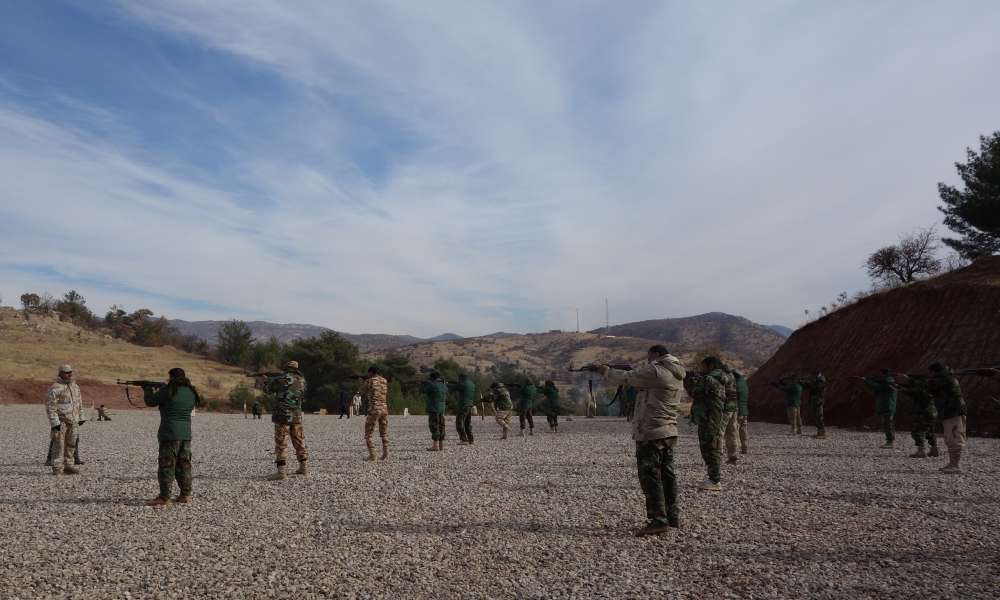
Kurdish Security Forces
The Kurdish Security Forces, also referred to as Peshmerga, comprises a range of forces, including traditional army forces, military and intelligence units, and others functioning more like local police. They have a total estimated strength of 190,000 to 250,000 fighters, but there are substantial ghost soldiers or part-time soldiers within those numbers.50 The Peshmerga’s level of command, control and organization puts it closer to a state force. They are the only legally recognized regional force under Article 117 of the 2005 Iraqi Constitution (which allows regions to establish their own internal security services, the “police, security forces and guards of the region”). Although Peshmerga are dominant in KRG territory, they have also long been active in some of the Disputed Territories that are jointly claimed by Iraq and the KRG, particularly following the 2014 ISIL crisis and collapse of Iraqi government authorities in these areas.
The most prominent KSF are loyal to one of the two main Kurdish political parties, the Kurdish Democratic Party (KDP) and the Patriotic Union of Kurdistan (PUK). The Peshmerga as a Kurdish fighting force grew out of Mustafa Barzani’s KDP guerrilla fighting against Baghdad in the 1970s. Due to political divisions, the PUK formed their own Peshmerga in the mid-1970s. The two parties with their forces continued to grow apart, culminating in a bloody civil conflict in 1994. A Peace Agreement in 1998 achieved nominal unification between the KDP and PUK Peshmerga forces, but most Peshmerga, including its two largest fighting forces, Division 70 and Division 80, continue to report to the PUK’s and KDP’s Political Bureaus. KDP-commanded Peshmerga are traditionally supported by Turkey, but ties have recently eroded due to KRG’s perceived cooperation with PKK-affiliated forces in the war against ISIL. The PUK has been supported by Iran, though the degree of affiliation and assistance is unclear.
There is also a nominally independent, integrated Peshmerga force of 14 brigades, created in 2009 and 2010, called the Regional Guard Brigades. They fall under the Ministry of Peshmerga (MoP), and at a brigade level leadership positions are distributed along a 50 – 50 principle: brigades headed by KDP commanders have PUK deputy commanders, and vice versa. In practice, however, most Regional Guard Brigades still break down along party lines. For example, the political parties and not the Ministry of Peshmerga Affairs appoint sector commanders responsible for ground operations.51 International Coalition members provide substantial training and equipment to Regional Guard Brigades. One of the main initiatives is the Kurdistan Training Coordination Centre (KTCC), a major training and equipment center for the MoP brigades, with equipment and weapons provided by the US and 7 other countries providing training. Other international actors also provide training and equipment to Peshmerga forces unilaterally, including Canada, and France.
While the vast majority of the Peshmerga are drawn from KRG’s Kurdish population, minorities (including Sunni Arabs, Christians and Yazidis) can and do join the Peshmerga as soldiers. Some have formed minority brigades within the Peshmerga, particularly following the 2014 crisis and the expansion of Peshmerga control to Disputed Territories. Several of these minority brigades will also be discussed below.
Regional Guard Brigades
Formed: 2010
Active: Yes
Strength: 14 Regional Guard Brigades, approx. 40,00052
Leaders: KRG President Masoud Barzani and KRG Ministry of Peshmerga Affairs (formally); PUK and KDP political leaders (de facto)
- Integrated Peshmerga under Ministry of Peshmerga Affairs, but de facto under PUK and KDP party control
- Leadership positions distributed along 50 – 50 principles: brigades headed by KDP commanders have PUK deputy commanders, and vice versa
- Training provided at KTCC sites by a 9‑member coalition (trainers provided by Italy, Germany, Hungary, Italy, the Netherlands, Norway, Finland, the United Kingdom, Turkey; Slovenia has one administrative member), with weapons and equipment provided by the United States
KDP-commanded Peshmerga Division 80
Formed: 1970s
Active: Yes
Strength: approx. 50,000 fighters
Leaders: KRG President and KDP leader Masoud Barzani (formally and de facto)
- KDP-affiliated Peshmerga units divided among regular units (Division 80), Zerevani (a special forces unit, which fall under the KRG MoI), and counter-terrorism forces
- Primary areas of operation in KDP zones of control (western half of Iraqi Kurdistan), Kirkuk, and Sinjar
- Reportedly receive Turkish support, including training at Bashiqa air base near Mosul
- Implicated in allegations of ethnic “clearing” policies – preventing the return of Arab communities once an areas has been cleared of ISIL
PUK-commanded Peshmerga
Formed: 1970s
Active: Yes
Strength: approx. 48,000 fighters
Leader: KRG President Masoud Barzani (formally); PUK SG Jalal Talabani (de facto)
- PUK-affiliated units typically divided according to regular units (Division 70) and Deja Terror (Counter-terrorism Forces)
- Operate in PUK zones of control: (eastern half of Iraqi Kurdistan), Kirkuk
- Reportedly have had some support from Iran in the past but unclear in what form
- Active in front-line combat against ISIL
- Implicated in allegations of ethnic “clearing” policies – preventing the return of Arab communities once an areas has been cleared of ISIL
Local Forces Affiliated with the KSF
A number of minority groups have established forces under the Peshmerga, including Shabak, Kakai, Yazidis and Christians. There is generally little information available about these groups and their conduct in war. They generally report to the Ministry of Peshmerga Affairs, and work within the KDP-led structure.
Yazidi Peshmerga
Formed: 2014
Active: Yes
Strength: approx. 10,000 fighters53
Leader: Qasim Shesho
- A Yazidi brigade allied with the Peshmerga
- Active in Sinjar
Rojava Peshmerga
Formed: 2014
Active: Yes
Strength: 3,000−6,000 fighters54
Leader: Brig. Gen. Mohammed Rejeb Dehdo
- Consist of Syrian Kurdish soldiers who fled the Syrian Army (but disagree with YPG/YPJ)55
- Training by the KDP-Peshmerga (Zeravani forces)56 and reportedly possible training by Turkey
- Intra-Kurdish differences prevent the militia from returning to Syria; hence, they fight ISIL in Iraq57
- Active mostly on southern fronts, Mosul and Kirkuk, and Syrian border near Sinjar and Rabi’a
Jazeera Brigade
Formed: 2017
Active: Yes
Strength: 2,000
Leader: Brig. Gen. Bolond Hussayn58
- A tribal force under the KDP-Peshmerga (Zeravani forces)
- Fighters hail from Kurdish-controlled Tal Afar district (Rabi’a, Ayadiya, Zummar)
- One unit of Arab fighters, the Ninewa Lions of Rabi’a, was originally part of the US-supported TMF forces, but switched over
- Primary goal is to hold areas cleared by KDP-aligned Kurdish forces; link between local tribal populations (primarily Sunni Arab) and the Kurdish forces
Ninewa Plains Guard Force (NPGF)
Formed: 2004
Active: yes
Strength: approx. 2,500 fighters
Leader: Sarkis Aghajan Mamendo (unconfirmed)
- Largest and most long-standing Christian militia, formed as a local guard force in the Qaraqosh area beginning in 2004
- KRG-affiliated, have received training from and are integrated under the KDP Zerevani
- Assigned to hold the north Ninewa Plains area (around Tal as-Soqf) along with NPF
Ninewa Plains Force (NPF)
Formed: 2014
Active: Yes
Strength: reportedly approx. 500 as of July 201559
Leader: Romeo Hakari
- One of the two pro-KRG Assyrian Christian militias in Iraq
- Equipment and training by the Peshmerga60
- Linked to Bet-Nahrain Democratic Party
- Operating north of Mosul alongside NPGF, assigned to help hold areas near Tal as Soqf61
- Tend to act as an auxiliary or supporting unit fighting alongside KDP Peshmerga, including in some frontline activities
Dwekh Nawsha
Formed: 2014
Active: Yes
Strength: 100 to 250 estimated
Leader: Lt. Col. Odisho
- All-volunteer force linked to the Assyrian Patriotic Party
- Trained and equipped by Peshmerga
- Operating near Tel as Soqf, north of Mosul
- Troops wear Zerevani badges62
- Reportedly receive some weapons and funding from the KDP, but are not as clearly acting as official sub-units of Kurdish forces as are the NPGF or NPF
- Reportedly includes up to 250 volunteers and a few foreigners63
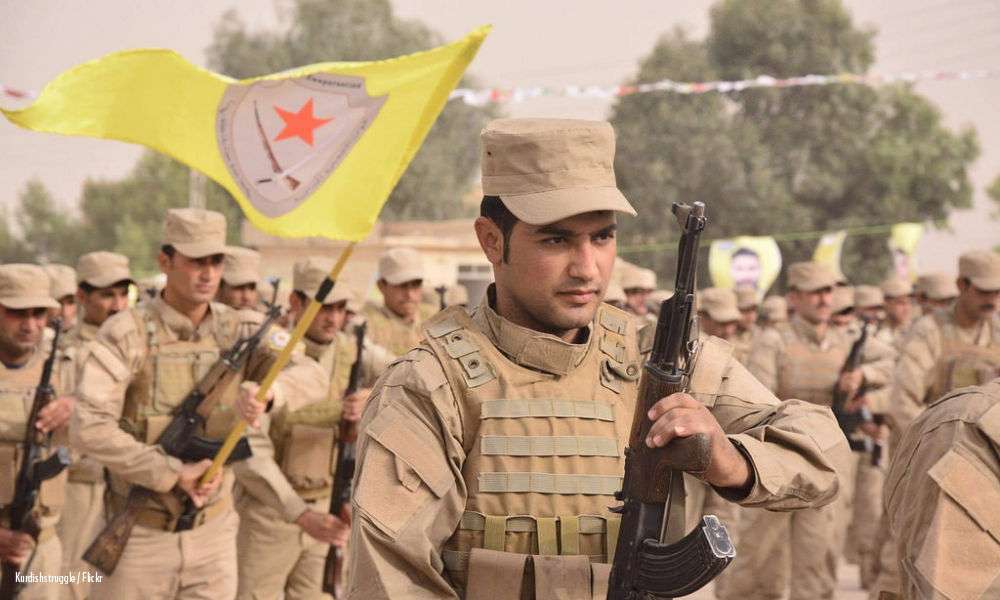
PKK-Affiliated Groups
A number of local or non-state forces operate independently from the Popular Mobilization Forces and the Peshmerga; most notably, the Kurdistan Worker’s Party (PKK) and its affiliates. Known primarily for its armed struggle against the Turkish state and movement for Kurdish autonomy, the PKK also took a significant part in the fight against ISIL in Syria via its local affiliate, the People’s Protection Units (YPG). Most PKK members have historically been recruited within Turkish borders. The war against ISIL in Iraq, however, combined with the two PKK victories over ISIL in Makhmour and Sinjar, has considerably increased the number of recruits from Iraqi Kurdistan. Similarly in Syria, PKK victories and control over Kobane and other areas have led to greater support among local populations.64
The PKK does not receive direct support from the Iraqi government or the KRG. However, the PKK’s presence is tolerated in the PUK-controlled parts of Kurdistan. In the 1980s, the PKK was already operating from Iraq as KDP’s Barzani allowed the construction of a base in the areas under his control. In 1999, the PKK announced a unilateral ceasefire and fully withdrew from Turkey to set up new training facilities in the Qandil Mountains of the Kurdistan Region of Iraq. This is now the headquarters of the PKK.65 Relations with the Kurdistan Regional Government (KRG) have waned more recently, and some have argued that the PKK is moving to align itself more closely with the PUK.66
Although the PKK and its affiliates did not figure predominantly in the field research sites, the PKK are relevant actors in terms of LHSF dynamics in the general areas where research was conducted. The YPG is widely lauded for saving thousands of Yezidis in Sinjar, Iraq by opening up an escape corridor in August 2014 to Rojava, Syria. The PKK’s and its affiliates’ success in Iraq and Syria have created a new center of gravity for LHSFs that do not sympathize with the KRG’s Peshmerga or Baghdad. For example, the most active Yazidi self-defense force, the Sinjar Resistance Units (YBS), is trained and supported by the PKK and the YPG. The Sinjar Resistance Units (YBS), for instance, are hostile to KRG-affiliated forces operating on the Zummar-Rabi’a front; they claimed that they could stage operations in Sinjar, which could potentially lead to conflict with the PKK-supported YBS.
People’s Defense Forces (Hêzen Parastina Gel, HPG)
Formed: 1984 (PKK formed in 1978)
Active: Yes
Strength: 7,000−10,000 troop67
Leader: Murat Karayilan (de facto PKK leader since 1999 and commander in chief of HPG)
- Armed wing of PKK leading struggle for Kurdish autonomy in Turkey
- HQ in Qandil mountains (PUK zone of control) but only began active combat operations in Iraq (Sinjar and Makhmour) in August 2014, where it was credited for important anti-ISIL military successes
- Iran provides covert logistical and financial support according to Turkish intelligence,68 but is otherwise largely self-supported (reportedly with criminal activities and trafficking)69
- In April 2016, PKK offered to contribute 4,000 fighters to the Mosul operation, pending Iraqi government approval
- Listed as a terrorist organization by Turkey, NATO, the United States, and the EU. The UN and other countries such as Switzerland, China, India, Russia and Egypt do not consider it to be a terrorist organization
- Reported human rights violations, including forced recruitment
People’s Defense Forces (Yekîneyên Parastina Gel, YPG)
Active: Yes
Leader: Nasreen Abdullah and Cihan Cendal
- Armed wing of the PYD leading the struggle for Kurdish autonomy in Syria
- While disputed, branch of the PKK and HPG
- Came to the rescue of Yezidis when they were trapped on Mt. Sinjar after ISIL attacked on August 3, 2014
- Reputation as hardened, well organized soldiers
- Supported by the US and Coalition forces in the fight against ISIL in Syria
- Has a female-only equivalent, the YPJ, which is present in Rabi’a (Tal Afar district), among other places
Sinjar Resistance Units (Yekîneyên Berxwedana Şengalê, YBS)
Formed: 2015
Active: Yes
Strength: 1,500−2,000 as of 201470
Leader: Khider Salih, head of the Autonomous Administrative Council, the political wing of YBS
- Founded by PKK and the YPG who continue to provide some military training and logistical support.71
- Iraqi Central Government provides financial support, paying the salaries of 1,000 fighters72
- Often portrayed as a tool of the PKK, but its leader argues the PKK does not control them.73
- Has a female equivalent, the Ezidxan Women’s Units (Yekinêyen Jinên Êzidxan, YJE), led by Da Shiereen Saleh (formerly known as Sinjar Women’s Protection Units
References
1 Michael Knights, “Iraq’s Popular Demobilization,” Al-Jazeera English, February 26, 2016, http://www.aljazeera.com/indepth/opinion/2016/02/iraq-popular-demobilisation-160224050939178.html; Michael Knights, The Future of Iraqi Armed Forces (Baghdad: Al-Bayan Center for Planning and Studies, 2016).
2 Of the approximately 120,000 on budget, approximately 60,000 are estimated to have pre-existed the 2014 crisis, whereas 40,000 have been organized since 2014. Ibid.
3 For his profile, see, “فلاح فياض قوته في صمته,” Asharq Al-Awsat, August 5, 2015, https://goo.gl/bJ1Nge.
4 “Badr Organization,” Counter Extremism Project, accessed August 18, 2017, http://www.counterextremism.com/threat/badr-organization; Susannah George, “Breaking Badr,” Foreign Policy, November 6, 2014, http://foreignpolicy.com/2014/11/06/breaking-badr.
5 Knights, “Iraq’s Popular.”
6 Dylan O’Driscoll and Dave van Zoonen, The Hashd al-Shaabi and Iraq: Subnationalism and the State (Erbil: Middle East Research Institute, 2017), http://www.meri‑k.org/wp-content/uploads/2017/03/PMF-Report‑0.2.pdf.
7 Ibid.
8 Loveday Morris, “Appointment of Iraq’s New Interior Minister Opens Door to Militia and Iranian Influence,” The Washington Post, October 18, 2014, https://www.washingtonpost.com/world/appointment-of-iraqs-new-interior-minister-opens-door-to-militia-and-iranian-influence/2014/10/18/f6f2a347-d38c-4743 – 902a-254a169ca274_story.html.
9 O’Driscoll and van Zoonen, Hashd al-Shaabi and Iraq.
10 Ibid.
11 “Iraq: Ban Abusive Militias from Mosul Operation,” Human Rights Watch, July 31, 2016, https://www.hrw.org/news/2016/07/31/iraq-ban-abusive-militias-mosul-operation; “Iraq: Ethnic Fighting Endangers Civilians Kurds, Turkmen, Arabs Clash in Northern District,” Human Rights Watch, January 13, 2016, https://www.hrw.org/news/2016/01/13/iraq-ethnic-fighting-endangers-civilians; Human Rights Watch, Ruinous Aftermath. Militias Abuses Following Iraq’s Recapture of Tikrit (New York: Human Rights Watch, 2015), https://www.hrw.org/report/2015/09/20/ruinous-aftermath/militias-abuses-following-iraqs-recapture-tikrit.
12 O’Driscoll and van Zoonen, Hashd al-Shaabi and Iraq.
13 Martin Chulov, “Controlled by Iraq, the Deadly Militias Recruit Iraq’s Men to Die in Syria,” Guardian, March 12, 2014, https://www.theguardian.com/world/2014/mar/12/iraq-battle-dead-valley-peace-syria.
14Abu Dura and Mustafa al Sheibani were added to the US global terrorist lists in January 2008, and are reported to have returned to Iraq and implicitly re-engaged. A number of other former leaders or commanders from the League of the Righteous were also added to the US global terrorist list for their coordination of or engagement in attacks against US forces from 2006 to 2009, but it is unclear if some of these other commanders have re-engaged with the League of the Righteous in current operations. Bill Roggio, “US Airstrikes in Amerli Supported Deadly Shi’a Group,” Long War Journal, September 2, 2014, http://www.longwarjournal.org/archives/2014/09/us_airstrikes_in_ame.php.
15 See supra note 11.
16 W.G. Dunlop, “Iraqi Sunnis Joined Feared Shi’a Militias to Fight IS,” Yahoo News, March 13, 2015, https://www.yahoo.com/news/iraqi-sunnis-join-feared-shiite-militia-battle-213921399.html?ref=gs.
17 Dina al-Shibeeb, “Iraqi Tribes Ready to Join Anti-ISIS Volunteer Forces, Says PMU Official,” Al-Arabia English, September 28, 2015, http://english.alarabiya.net/en/perspective/profiles/2015/09/28/Iraqi-tribes-ready-to-join-anti-ISIS-volunteer-forces-says-PMU-official-.html.
18 Babak Dehghanpisheh, “Special Report: The Fighters of Iraq Who Answer to Iran,” Reuters, November 12, 2014, http://www.reuters.com/article/us-mideast-crisis-militias-specialreport-idUSKCN0IW0ZA20141112.
19 Knights, “Iraq’s Popular.”
20 “Treasury Designates Individual, Entity Posing Threat to Stability in Iraq,” U.S. Department of Treasury Press Center, July 2, 2009, https://www.treasury.gov/press-center/press-releases/Pages/tg195.aspx; “Designation of Kata’ib Hizballah as a Foreign Terrorist Organization,” U.S. Department of State, accessed August 18, 2017, http://www.state.gov/r/pa/prs/ps/2009/july/125582.htm.
21 O’Driscoll and van Zoonen, Hashd al-Shaabi and Iraq.
22 Nour Malas, “The Militia Commander Beating Back ISIS in Iraq Makes the U.S. Nervous,” Wall Street Journal, June 2, 2016, http://www.wsj.com/articles/the-militia-commander-beating-back-isis-in-iraq-makes-the-u-s-nervous-1464890675.
23 See supra note 11.
24 O’Driscoll and van Zoonen, Hashd al-Shaabi and Iraq.
25 Matthew Levitt and Phillip Smyth, “Kataib al-Imam Ali: Portrait of an Iraqi Shiite Militant Group Fighting ISIS,” Washington Institute, January 5, 2015,
26 “‘The Archangel of Death’ Fighting Islamic State,” BBC News, March 18, 2015, http://www.bbc.com/news/blogs-trending-31913278.
27 Richard Spencer, “Iraqi Shi’a Militia Who Fought ISIL Condemned for Revenge Beheadings,” Telegraph, September 10, 2014, http://www.telegraph.co.uk/news/worldnews/middleeast/iraq/11087584/Iraqi-Shi’a‑militia-who-fought-Isil-condemned-for-revenge-beheadings.html; “Video Purports to Show Militia Atrocity in Iraq,” Al Jazeera, May 31, 2015, http://www.aljazeera.com/news/2015/05/video-purports-show-militia-atrocity-iraq-150531150815036.html.
28 Levitt and Smyth, “Kataib al-Imam Ali”; al-Shibeeb, “Iraqi Tribes Ready.”
29 Ned Parker, Babak Dehghanpisheh and Isabel Coles, “How Iran’s Military Chief Operates in Iraq,” Reuters, February 24, 2015, http://www.reuters.com/investigates/special-report/mideast-crisis-committee/.
30 Bilgay Duman, A New Controversial Actor in Post-ISIS Iraq: Al-Hashd Al-Shaabi, trans. Sercan Doğan (Ankara: ORSAM, 2015), http://www.orsam.org.tr/files/Raporlar/rapor198/198eng.pdf.
31 O’Driscoll and van Zoonen, Hashd al-Shaabi and Iraq.
32 Ibid.
33 Ibid.
34 “Mahdi Army,” Stanford Mapping Militant Organizations, last updated January 17, 2017, http://web.stanford.edu/group/mappingmilitants/cgi-bin/groups/view/57.
35 O’Driscoll and van Zoonen, Hashd al-Shaabi and Iraq.
36 Ibid.
37 Ibid.
38 Ibid.
39 Ibid.
40 “Special Presidential Envoy Brett McGurk in Iraq,” last updated June 21, 2016, U.S. Embassy and Consulates in Iraq, http://iraq.usembassy.gov/pr-062116.html
41 Ali Kurdistani, “Why Sunnis Don’t Want Shiite Militia in the Mosul Offensive,” Rudaw, July 1, 2016,
http://rudaw.net/english/middleeast/iraq/01072016.
42 Zana Gulmohamad, “Unseating the Caliphate: Contrasting the Challenges of Liberating Fallujah and Mosul,” CTC Sentinel 9, no. 10 (October 2016):16, https://www.ctc.usma.edu/posts/unseating-the-caliphate-contrasting-the-challenges-of-liberating-fallujah-and-mosul.
43 O’Driscoll and van Zoonen, Hashd al-Shaabi and Iraq.
44 See supra note 11.
45 Philip Smyth, “Quwat Sahl Nīnawā: Iraq’s Shi’a Shabak Get Their Own Militia,” Jihadology, January 12, 2015, http://jihadology.net/2015/01/12/hizballah-cavalcade-quwat-sahl-ninawa-iraqs-Shi’a‑shabak-get-their-own-militia/.
46 Aymenn Jawad Al-Tamimi, “Journeys to Mosul,” Middle East Review of International Affairs, June 15, 2017, http://www.meforum.org/6769/journeys-to-mosul.
47 Belkis Wille, “Integrating Iraqi Fighting Forces Is Not Enough,” Human Rights Watch, January 6, 2017, https://www.hrw.org/news/2017/01/06/integrating-iraqi-fighting-forces-not-enough.
48 Jack Moore, “‘4,000-Strongs’ Christian Militias Formed to Fight ISIS in Northern Iraq,” Newsweek, February 4, 2015, http://europe.newsweek.com/4000-strong-christian-militia-formed-fight-isis-northern-iraq-304371?rm=eu.
49 PAX for Peace, Sinjar after ISIS: Returning to Disputed Territory (Utrecht: PAX for Peace, 2016), https://www.paxforpeace.nl/stay-informed/news/sinjar-after-isis-returning-to-disputed-territory.
50 Fazel Hawramy, “Kurdish Peshmerga Divisions Hamper War Effort,” Al-Monitor, January 13, 2015,
http://www.al-monitor.com/pulse/originals/2015/01/iraq-kurdish-peshmerga-division-islamic-state.html.
51 Wladimir van Wilgenburg and Mario Fumerton, Kurdistan’s Political Armies: The Challenge of Unifying the Peshmerga Forces (Washington, DC: Carnegie Endowment for International Peace, 2015), http://carnegieendowment.org/files/ACMR_WilgenburgFumerton_Kurdistan_English_final.pdf.
52 Ibid.
53 Christine McCaffray van den Toorn, “The Wars after the War for Sinjar. How Washington Can Avert a New Civil War,” War on the Rocks, June 20, 2010, http://warontherocks.com/2016/06/the-wars-after-the-war-for-sinjar-how-washington-can-avert-a-new-civil-war/; Mohammed A. Salih, “With the Islamic State Gone from Sinjar, Kurdish Groups Battle for Control,” Al-Monitor, December 10, 2015, http://www.al-monitor.com/pulse/originals/2015/12/iraq-kurdistan-sinjar-liberated-isis-hegemony.html.
54 Hisham Arafat, “Syrian Kurdish Women Join Peshmerga,” Kurdistan 24, January 12, 2016, http://www.kurdistan24.net/en/sport/75952338 – 772a-453d-bef6-24b82a1adf72/Syrian-Kurdish-women-join-Peshmerga.
55 Ibid.
56 David Ignatius, “How the Kurds’ Neighbors Play Games to Block the Expansion of ‘Greater Kurdistan’,” Washington Post, May 27, 2016, https://www.washingtonpost.com/blogs/post-partisan/wp/2016/05/27/kurdish-factions/.
57 Ibid.
58 “Peshmerga Graduates the First Class of Arab Volunteers from Ninewa,” Al Jazeera, August 2, 2017, https://goo.gl/HTw9g3.
59 Matt Cetti-Roberts, “Inside the Christian Militias Defending the Nineveh Plains: Some Work with the Peshmerga, Some Don’t — and They Only Trust Their Own,” War Is Boring, March 6, 2016, https://warisboring.com/inside-the-christian-militias-defending-the-nineveh-plains-fe4a10babeed#.7uusgok1r; Salih,“With the Islamic State Gone.”
60 Cetti-Roberts, “Inside the Christian Militias.”
61 Based on interviews with NPF representatives, members of the KTCC, and diplomatic officials involved with the Coalition, the NPF have received training as part of the Peshmerga through the KTCC, which is the Peshmerga training program supported by nine coalition members, including Germany, Italy, the Netherlands, and Hungary, among other nations.
62 Peter Henderson, “Iraq’s Christian Paramilitaries Split in IS Fight,” Al-Monitor, October 30, 2014, http://www.al-monitor.com/pulse/originals/2014/10/iraq-christian-paramilitary-forces-nineveh.html.
63 “Christians Reclaim Iraq Village from ISIS,” CBS News, November 13, 2014, http://www.cbsnews.com/news/christian-iraq-village-kurdish-peshmerga-fighters-bakufa-isis/; Cetti-Roberts, “Inside the Christian Militias.” Reports indicate that two Americans, and eight foreigners, in total, have joined the militia. Henderson, “Iraq’s Christian Paramilitaries”; Rebecca Collard, “Meet the Americans Who Have Joined an Iraqi Militia to Fight ISIS,” Time, March 27, 2015, http://time.com/3761211/isis-americans-iraqi-militias/.
64 ’’Sectarian Strategies, National Settings and the War Economy in Syria and Iraq,”NORIA, July 16, 2014, http://www.noria-research.com/sectarian-strategies-national-settings-and-the-war-economy-in-syria-and-iraq/.
65 “Chronology of the Important Events in the World/PKK Chronology,” Turkish Weekly, May 27, 2007, http://www.turkishweekly.net/2007/05/27/article/chronology-of-the-important-events-in-the-world-pkk-chronology-1976 – 2006/.
66 Gokhan Bacik and Bezen Balamir Coskun, “The PKK Problem: Explaining Turkey’s Failure to Develop a Political Solution,” Studies in Conflict & Terrorism 34, no.3 (2011): 261.
67 5,000 fighters in Sinjar area and hundreds more along the Makhmour frontline, as of April 2016. An additional 3,500 troops in Turkey (Nusaybin area), as of 2013. Approx. 300 fighters in northern Syria, mainly Kobane (Ayn al-Arab), Derik (Al-Malikiyah), and Afrin regions. “Facts And Figures: Kurdistan Workers Party,” Radio Free Europe Radio Liberty, March 21, 2013, http://www.rferl.org/content/profile-history-pkk-kurdish/24935503.html; “Leadership Reshuffle — PKK Makes Changes in Its Ranks,” IHS Global Limited, February 26, 2014, http://www.washingtoninstitute.org/uploads/Documents/opeds/Cagaptay20140226-Janes.pdf; Mahmut Bozarslan, “Why the PKK Is So Interested in Mosul,” Al-Monitor, April 12, 2016, http://www.al-monitor.com/pulse/originals/2016/04/turkey-iraq-syria-pkk-interest-in-mosul.html#ixzz4RsYzmNki.
68 Cengiz Çandar, “Turkey Claims Iran Providing Logistical Support for PKK,” Al-Monitor, December 30, 2012, http://www.al-monitor.com/pulse/originals/2012/al-monitor/iran-turkey-shiite-sunni-pkk.html#ixzz4F3J33gkt.
69 In 2007, STRATFOR estimated the PKK makes $300 – 400 million per year from related activities. Another source puts the PKK’s budget at its peak in the 1990s at about $86 million per year. In 2002, Germany’s chief prosecutor asserted that “80 percent of narcotics seized in Europe were linked to the PKK or “other Turkish groups” which then have used the profits from illegal narcotics to purchase arms.” Glenn E. Curtis and Tara Karacan, The Nexus among Terrorists, Narcotics Traffickers, Weapons Proliferators, and Organized Crime Networks in Western Europe (Washington, DC: Library of Congress – Federal Research Division, 2002), 20, https://www.loc.gov/rr/frd/pdf-files/WestEurope_NEXUS.pdf; See also, “Treasury Sanctions Supporters of the Kurdistan Workers Party (PKK) Tied to Drug Trafficking in Europe,” U.S. Department of Treasury Press Center, February 1, 2012, https://www.treasury.gov/press-center/press-releases/Pages/tg1406.aspx; Denise Natali, “Can Ocalan Rein In the PKK?” Al-Monitor, January 17, 2013, http://www.al-monitor.com/pulse/originals/2013/01/ocalan-tuks-pkk.html#ixzz4FifcTzAR.
70 Shamal Abdullah, “Yazidis Form Militia to Protect Sinjar Mountain,” ANIA, August 6, 2014, http://www.aina.org/news/20140806125221.htm.
71Joanna Paraszczuk, “Yazidi Militias Fight IS in Iraq, Amid Kurdish Rivalries,” Radio Free Europe Radio Liberty, June 11, 2015, http://www.rferl.org/content/islamic-state-yazidi-militias-kurdish-region/27066780.html.
72 Van den Toorn,“Wars after the War.”
73 Ibid.


